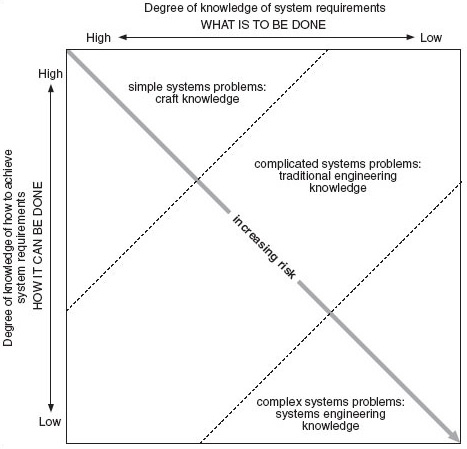1.5 Increasing complication, complexity and risk: the underlying relationship
Figure 3 showed five commonly encountered problems of effecting different types of change. These are notionally located on a spectrum of change that ranges from no change at all, to complete revolution. The relationship suggested on the figure is that as the degree of change – represented by the different types of problem – increases so, too, do difficulty and risk. Each of the five problems of effecting change can be regarded as a gap between an existing situation and an alternative, desired or preferable situation. To close these gaps, be they the correction of faults or the design and implementation of a completely new, innovative system, requires the deployment and consumption of resources. These resources may be a mixture people, materials, equipment, objects, and information. These two characteristics of change – the nature of the change problem and the use of resources – can be used as the basis for developing the picture shown in Figure 3 into a more complete model of change, and taken together represent the certainty of outcome of a change project.
Figure 9 shows change problems divided into three categories; simple, complicated and complex. The two dimensions of the problem of effecting change, knowing what is required and knowing how to achieve what is required are shown as two axes that each run from high to low – from complete knowledge and certainty to ‘haven't a clue’. Change problems are rendered (relatively) simple by a high degree of knowledge of what needs to be done and how to do it. I have termed the dominant form of knowledge required to address this type of problem as ‘craft knowledge’, since it is the product of a learning that is essentially experiential in character, being a result of meeting and tackling successfully similar problems in the past. This craft knowledge has been termed as ‘tacit’ and may be embedded in individuals or in the organisation itself in informal rules and procedures. In such situations certainty of outcome is high.
As uncertainty increases the change problem becomes more complicated and less amenable to solution through the application of tacit knowledge. Knowledge of what is needed or how to achieve what is required, or both, is less certain. In such situations those involved are likely to fall back on formal knowledge, either of first principles or that which has been embedded in formal rules and procedures. These complicated change tasks are often solved by the application of traditional engineering knowledge.
The third type of change problem shown in Figure 9 has high uncertainty as it is complex. Traditional forms of engineering knowledge no longer suffice and it is in application to this type of problem that systems engineering knowledge comes into its own. This type of knowledge is both ‘systemic’ and ‘systematic’. It is systemic because, being based on the systems principle of ‘holism’ , it views the change problem as a whole, resisting the inclination to see it from the perspective of a particular function or discipline. It is ‘systematic’ because it embodies rational frameworks and approaches that reduce uncertainty.

Question 2
Do you consider that the degree of knowledge of what is to be done and how it can be achieved explains the increasing risk completely?
Answer
This point gave rise to a fierce debate in the original Course Team. The External Assessor argued strongly that there are other factors than the degree of knowledge that contribute to complexity such as the increased coupling of systems and the strength and breadth of their interaction. These give rise to stronger emergent behaviour. While agreeing with this point, others stated that it was the lack of knowledge and, therefore, the failure to predict these factors that gave rise to increasing risk.
An example of the three types of change problem will help to illustrate the model. Suppose that I want to extend the electrical wiring in my house into the garden to run some lights and a water feature. Designing an extension of this type is well within the capability of a competent electrician, and I am confident that the lights and water feature can be got to work satisfactorily and safely. Craft knowledge of a readily available kind is required to deal successfully with this simple problem.
A more complicated problem is consequent on a decision to install a new security system for the house. This requires more specialist knowledge than a simple extension to existing wiring and is a more difficult design task. I am likely to employ a firm that specialises in this type of project, which may also involve, in supporting roles, other areas of knowledge such as glaziers, plasterers and so on.
The complex level of change problem can be illustrated by the decision of a building company to design a dwelling with a fully automated control system. Since, as yet, only limited prototypes of this type of accommodation have been developed, the requirements and functionality of such a system are uncertain. Equally vague are the domains of knowledge that would be needed to design and implement such a system successfully. As a result, the outcomes of a project to design a ‘house automation system’ are highly uncertain.
Four observations can be made about the change problem model presented in Figure 9. Uncertainty increases with the degree of turbulence in the environment of the change problem. This turbulence may be associated with change in:
-
underlying technologies, either those embodied in the product or service in question or those that are to do with how to achieve what is required
-
the business or competitive environment
-
the political environment
-
the social environment
-
the economic environment.
The existing knowledge base of individuals and organisations will bias their perception of a problem and how it can be solved. The organisation may suffer from unconscious incompetence, not being aware of what it does not know. These two factors, environmental change and perception of the nature of the problem, increase the degree of uncertainty that is associated with a need for change and, consequentially, with its riskiness.
Risk can be denned as the probability of an unexpected outcome. Naturally enough we have an asymmetrical attitude to unexpectedness. We don't mind positive unexpected outcomes but want to avoid nasty ones and their consequences. Our tendency is, therefore, to be risk averse, and only if we are offered a greater return for doing so will we take on extra risk:
-
those undertaking dangerous sports are compensated by the psychological return that they provide, or the social status that participation confers
-
punters on a horse race are offered better odds on outsiders than on the favourite
-
motor insurance companies want bigger premiums from drivers with a poor claims history
-
investors in the stock market demand greater returns from shares that are more volatile than the average of the market as a whole.
As a consequence, though it may be tempting to do so, businesses which undertake only safe forms of change, those that fall within their comfort zone, will not do better than the average. Taking on risk is uncomfortable but necessary because it brings with it greater financial returns and increased knowledge and learning. Systems engineering is a way of reducing the inherent riskiness of the new and complex.
In the remainder of this section of the course I will discuss the issues for systems engineering associated with the topics of simplicity, complication, and complexity.
Following the model in Figure 9, these closely related and, in some instances, overlapping topics will be examined in relation to the difficulty that they create for a systems engineer in terms of what he or she has to do, and the way that the work is performed.
